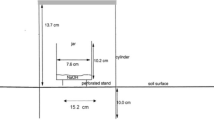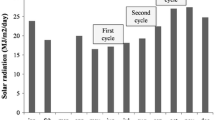Summary
Sources of N used by cropped and intercropped cowpeas and rice were determined by the 15N isotope-dilution technique. The biological efficiency of intercropping cowpeas and rice was assessed by calculating the land equivalent ratio of dry matter yield, total N, and uptake of N. A reduced N uptake by both cowpeas and rice during mixed cropping was attributed to mutual competition, with both crops competing effectively for the scarce environmental resources. The lack of a significant difference in the uptake of fertilizer and soil N by mixed-crop rice and cowpeas is an indication that the soil N was sufficient and that the mixed cropping did not create any imbalance in soil and fertilizer N uptake. The land equivalent ratio ranged between 120% and 180% for shoot dry matter and total N, showing that biological efficiency was increased by intercropping cowpeas with rice. The proportion of N derived from the atmosphere by mono- and intercropped cowpeas was not significantly different, showing that the potential of cowpeas to fix N2 was independent of the cropping system, since the rice did not stimulate the cowpeas to fix more N2.
Similar content being viewed by others
References
Agboola AA, Fayemi AA (1972) Fixation and excretion of nitrogen by tropical legumes. Agron J 64:409–412
Andrews DJ, Kassam AH (1976) The importance of multiple cropping in increasing food supplies. In: Papendick RI, Sanchez RA, Triplet CB (eds) Multiple cropping symposium. Am Soc Agron, Madison, Wisconsin, pp 1–10
Bandyopadhyay SK, Rajat D (1986) N relationship in a legume non legume association grown in an intercropping system. Fert Res 10:73–82
Betts WC (1977) Multiple cropping of maize and soybean. J Agric Sci 25:95–102
Bremner JM (1965) Total nitrogen. In: Black CA, Evans DD, White JL, Ensminger LE, Clark FE (ed) Methods of soil analysis part 2. Agronomy 9 Am Soc Agron, Madison, Wisconsin, pp 1149–1178
Eaglesham ARJ, Ayanaba A, Rango Rao V, Eskew DL (1981) Improving the nitrogen nutrition of maize by intercropping with cowpea. Soil Biochem 13:169–171
Fried M, Middleboe V (1977) Measurement of amount of nitrogen fixed by a legume crop. Plant and Soil 47:713–715
Haynes RJ (1980) Competitive aspects of the grass legume association. Adv Agron 33:227–261
Jensen SE (1986) Intercropping field bean with spring wheat. In: Proceedings of a Workshop in the CEC Programme of Coordination of Agricultural Research, July 16–19, 1986. University of Göttingen, Germany, Vorträge für Pflanzenzüchtung 11; pp 67–75
Kessel VC, Roskoski PJ (1988) Row spacing effects on N2 fixation, N yield and soil N uptake of intercropped cowpea and maize. Plant and Soil 11:17–23
Martin RC, Voldeng HD, Smith DL (1991) Nitrogen transfer from nodulating soybean to maize or to non-nodulating soybean in intercrops: the 15N dilution method. Plant and Soil 132:53–63
Mead R, Wiley RW (1980) The concept of a land equivalent ratio and advantages in yield from intercropping. Expl Agric 16:217–228
Ofori F, Pate JS, Stern WR (1987) Evaluation of N2 fixation and nitrogen economy of a maize/cowpea intercrop system using 15N dilution methods. Plant and Soil 102:149–160
Ofori F, Stern WR (1987) Cereal-legume intercropping systems. Adv Agron 41:41–89
Wiley RW (1978) Intercropping — its importance and research needs. Part 1, Competition and yield advantages. Field Crop Abstr 32:1–10
Author information
Authors and Affiliations
Rights and permissions
About this article
Cite this article
Okereke, G.U., Ayama, N. Sources of nitrogen and yield advantages for monocropping and mixed cropping with cowpeas (Vigna unguiculata L.) and upland rice (Oryza sativa L.). Biol Fertil Soils 13, 225–228 (1992). https://doi.org/10.1007/BF00340580
Received:
Issue Date:
DOI: https://doi.org/10.1007/BF00340580




